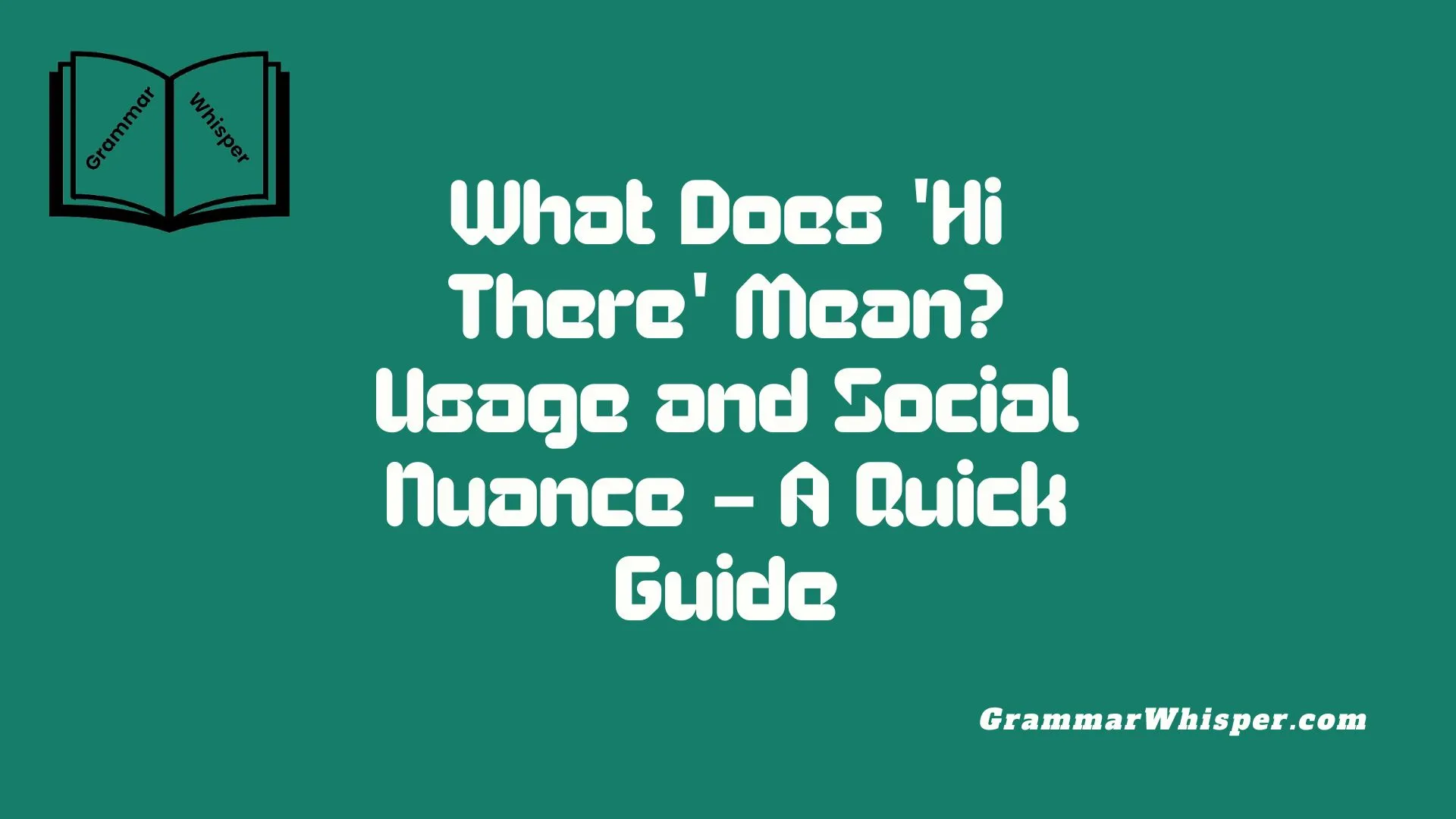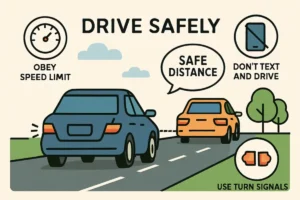In everyday communication, we lean on simple yet effective phrases to navigate the subtleties of connection. One such greeting – “Hi There” – has a surprisingly rich usage that goes beyond its casual appearance. From my own experience, it helps set an approachable tone, building human connection instantly without overstepping boundaries. Whether you’re chatting with a friend or a colleague, it strikes the right balance, making the speaker feel both familiar and respectful. Its tone-setting ability is so natural that we often overlook the subtle cues – a smile, a nod, eye contact – that come with it, all quietly processed by our subconscious. That’s why this phrase continues to thrive across nearly every kind of relationship.
As someone who studies and works with language, I see “Hi there” as more than a simple opener. It’s a dynamic phrase whose meaning shifts based on context. If someone uses it in a formal email, it might come across as open and inclusive. In a quick text, it feels lighthearted. That adaptive versatile nature is why it remains prevalent in modern speech. When you use it well, it serves as a social guide, letting people know your intention without needing elaborate wording. It may look basic, but its staying power proves how effective “Hi there” is in maintaining fluid, meaningful interaction.
What Does “Hi There” Actually Mean?
At its core, “Hi there” is a casual, friendly greeting. It’s used to acknowledge someone, often in an approachable or lighthearted way. But to understand its full nuance, let’s break down the phrase itself:
- “Hi” – A simple, informal form of “hello.”
- “There” – Adds a touch of distance or surprise, often implying “I see you” or “Hey, you over there.”
“Hi there” isn’t just a synonym for hello. It implies attention, warmth, and sometimes even familiarity – depending on the context.
The Origins of “Hi There”: A Brief History
The phrase “Hi there” has roots in early American English, and its structure aligns with the way English speakers began using more expressive, casual forms of address in the 19th and 20th centuries.
Where it comes from:
- “Hi” appeared in the English language in the 15th century as a form of exclamation – used to attract attention.
- “There” evolved to indicate direction or distance, which, when combined with “hi,” creates a greeting that draws someone in.
Pop culture influence:
“Hi there” became widely recognized thanks to radio shows, television characters, and advertising slogans in the mid-1900s. One classic example?
“Hi there, neighbor!” – a friendly, disarming phrase used by early American TV hosts.
Over time, it morphed into a modern casual greeting with universal flexibility.
How “There” Enhances the Greeting
Adding “there” to a simple “hi” changes the tone and feel of the message. Let’s look at how:
| Greeting | Tone | Emotional Color |
| Hi | Neutral | Direct, simple |
| Hi there | Warm, curious | Friendly, slightly playful |
| Hey there | Even more casual | Often flirty or laid-back |
| Hello there | Slightly formal | Nostalgic, sometimes theatrical |
The word “there” adds a hint of narrative – as if the speaker is spotting someone unexpectedly and acknowledging their presence.
How “Hi There” Is Used in Spoken English
In spoken conversation, “Hi there” can show up in many social scenarios:
Everyday uses:
- Greeting a customer in a store: “Hi there! How can I help you today?”
- Starting a phone conversation casually: “Hi there, this is Sarah calling about your order.”
- Addressing a child or pet playfully: “Hi there, little one!”
Tone matters:
- A warm, rising tone = friendly.
- A flat tone = neutral or formal.
- A slow, drawn-out “Hi there…” = possibly flirty or mocking, depending on the situation.
The same phrase can mean different things based on how you say it.
When to Use “Hi There” and When to Avoid It
Not every situation calls for “Hi there.” While it’s friendly, it might feel too casual or even inappropriate in formal or high-stakes settings.
Ideal for:
- Informal emails or texts
- Chatting with acquaintances
- Customer service conversations
- Social media or brand interactions
Avoid in:
- Job applications or cover letters
- Formal business introductions
- Legal or contractual communication
- Addressing someone of significantly higher status
Case Study: Customer Support Email
Scenario: A tech company responds to a customer complaint.
Option A – Formal:
Dear Customer, We received your message regarding issue #39429…
Option B – Casual:
Hi there, Thanks for reaching out! We’ve reviewed your ticket…
Result: Option B feels more human and empathetic – ideal for customer service.
Understanding the Role of Context in Choosing “Hi There”
Tone and context go hand in hand. Who you’re speaking to – and your relationship with them – heavily influences whether “Hi there” will come across as welcoming or inappropriate.
Examples by relationship:
| Relationship | Appropriate? | Notes |
| Close friend | ✅ | Perfectly casual |
| Romantic interest | ✅ (depends on tone) | Can be playful or flirty |
| Coworker (informal setting) | ✅ | Use sparingly in written communication |
| Boss or executive | ❌ | Too casual; use “Hello” or “Good morning” |
| Client (first contact) | ❌ | “Hi” is safer; “Hi there” might feel presumptive |
Is “Hi There” Friendly or Flirty? Or Both?
Tone, body language, and punctuation turn this phrase into a tone-shifting tool.
Friendly:
- Accompanied by a smile
- Neutral punctuation (“Hi there.” or “Hi there!”)
- Often used in service, casual networking
Flirty:
- Paired with emojis (“Hi there 😉”)
- Drawn out in speech (“Hiiiii there…”)
- Context: Dating apps, light teasing
Tip: If you’re unsure, observe the recipient’s tone in return.
How Different Cultures View “Hi There”
United States:
- Common in emails, chats, and customer service
- Warm and accessible
United Kingdom:
- Seen as slightly Americanized
- “Hi” or “Hello” is more common
Australia:
- Often replaced with “G’day” or “Hey there”
- Very informal, laid-back culture
Canada:
- Similar to U.S. usage
- Politeness still plays a role; “Hi there” is fine in friendly settings
Table: Greeting Preferences Across English-Speaking Countries
| Country | Preferred Greeting | Tone | Use Case Example |
| USA | “Hi there” | Warm, casual | Emails, chat |
| UK | “Hello” | Polite, neutral | Office settings |
| Australia | “Hey there” / “G’day” | Extremely casual | Social events |
| Canada | “Hi” or “Hi there” | Polite, friendly | General use |
Formal vs. Informal Greetings: How to Pick the Right One
Formality depends on:
- Relationship
- Setting
- Platform (spoken, email, social media)
- Intention
Greeting scale diagram:
plaintext
CopyEdit
Yo – > Hey – > Hi – > Hi there – > Hello – > Good day – > Dear [Name]
(Casual) (Formal)
Use greetings to match the vibe you want to project. A wrong greeting can set the wrong tone – even before you say anything else.
How to Respond to “Hi There”
The best response depends on the situation and your relationship with the speaker.
Friendly:
- “Hey!”
- “Hi there!” (mirror back)
- “Hello!”
Neutral:
- “Hi.”
- “Good to hear from you.”
Flirty:
- “Well hey there 😉”
- “Hi yourself!”
- “Fancy seeing you here.”
Tip: Mirror the tone of the greeting unless you want to steer the interaction in a new direction.
Phrases Similar to “Hi There”
Let’s explore some variations and their vibes:
| Phrase | Tone | Notes |
| “Hey there” | Very casual | Friendlier than “Hi there”; often playful |
| “Hello there” | Formal or dramatic | Used in pop culture (e.g., Obi-Wan Kenobi) |
| “Hi ya” | Retro/informal | Seen as dated in some regions |
| “Howdy” | Regional (U.S. South/West) | Friendly and relaxed |
Pop Culture Spotlight:
“Hello there.” – Obi-Wan Kenobi, Star Wars: Revenge of the Sith
Now widely used as a meme and humorous online greeting.
Digital Communication: The Rise of “Hi There” in Emails and UX
With the growth of email marketing, chatbots, and app notifications, “Hi there” has carved a new space.
Common in:
- Newsletter openings
- Onboarding emails
- Welcome messages in apps
Why it works:
- It’s non-threatening
- It feels personal without being overfamiliar
- It invites engagement without pressure
Conclusion
If your goal is to sound:
- Approachable
- Friendly
- Human
Then “Hi there” is a great choice – especially in informal settings, digital communication, or when trying to reduce social friction.
But if your setting is formal, legal, or highly professional? Stick to a more neutral greeting like “Hello” or “Good morning.”
Ultimately, your greeting sets the tone for everything that follows. Choose wisely, and you’ll build stronger rapport – whether in speech, text, or email.
Bonus Resources
- ✅ Grammarly: Greeting Tone Tips
- ✅ Cambridge Dictionary: “Hi There” Meaning
- ✅ Merriam-Webster: Hi Definition
Free Download: Greeting Selection Cheat Sheet
| Context | Suggested Greeting |
| Cold outreach email | “Hello” or “Hi” |
| Friendly business email | “Hi there” |
| Social message | “Hey” or “Hi there” |
| Formal communication | “Dear [Name]” |
If you’d like this post turned into a downloadable PDF, or broken down into a short-form infographic, just say the word. Would you like me to draft a short meta description and title tag optimized for SEO as well?
Faqs
What does “Hi there” mean in a conversation?
“Hi there” is a casual and friendly greeting often used to acknowledge someone in an approachable or slightly informal way. It conveys warmth and openness and can be used both in speech and writing. It’s less formal than “Hello” but more engaging than just “Hi.”
Is “Hi there” too informal for emails?
It depends on the context. “Hi there” works well in informal or semi-professional emails, like customer service, newsletters, or internal communication. However, it should be avoided in formal emails such as job applications or legal correspondence. In those cases, opt for “Hello” or “Dear [Name].”
Can “Hi there” be considered flirty?
Yes, in some contexts. If said with a playful tone, emoji, or suggestive body language, “Hi there” can sound flirtatious. On dating apps or between people with romantic interest, it may be interpreted that way. However, it is not inherently flirty – tone and context matter most.
What’s the difference between “Hi” and “Hi there”?
“Hi” is a direct, simple greeting. “Hi there” adds a bit more friendliness or surprise, as if you’ve just noticed the person. It can feel slightly more engaging or conversational. Think of it as a way to personalize the basic “Hi.”
Is it okay to use “Hi there” in a professional setting?
In casual workplace interactions or internal chats, yes. “Hi there” is perfectly fine when you’re greeting colleagues you know well or when trying to create a relaxed tone. For external communications or first-time professional contacts, it’s safer to use “Hi,” “Hello,” or “Dear [Name]” instead.












Hey! I know this is somewhat off topic but I was wondering which
blog platform are you using for this website?
I’m getting fed up of WordPress because I’ve had
problems with hackers and I’m looking at alternatives for another platform.
I would be great if you could point me in the direction of a good
platform.
I am using WordPress because you can use WordFence plugin with premium version that provide security. If you need further help you can contact me on spectraxminds@gmail.com.